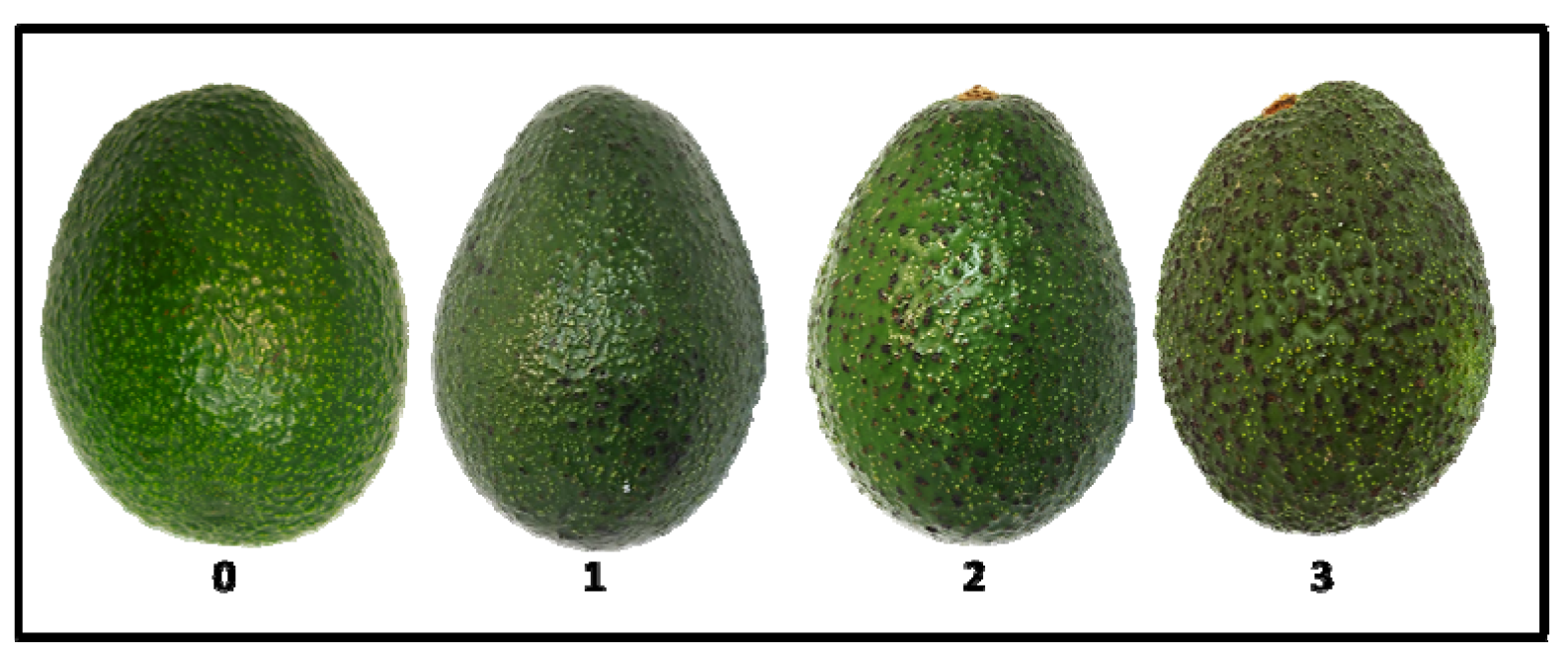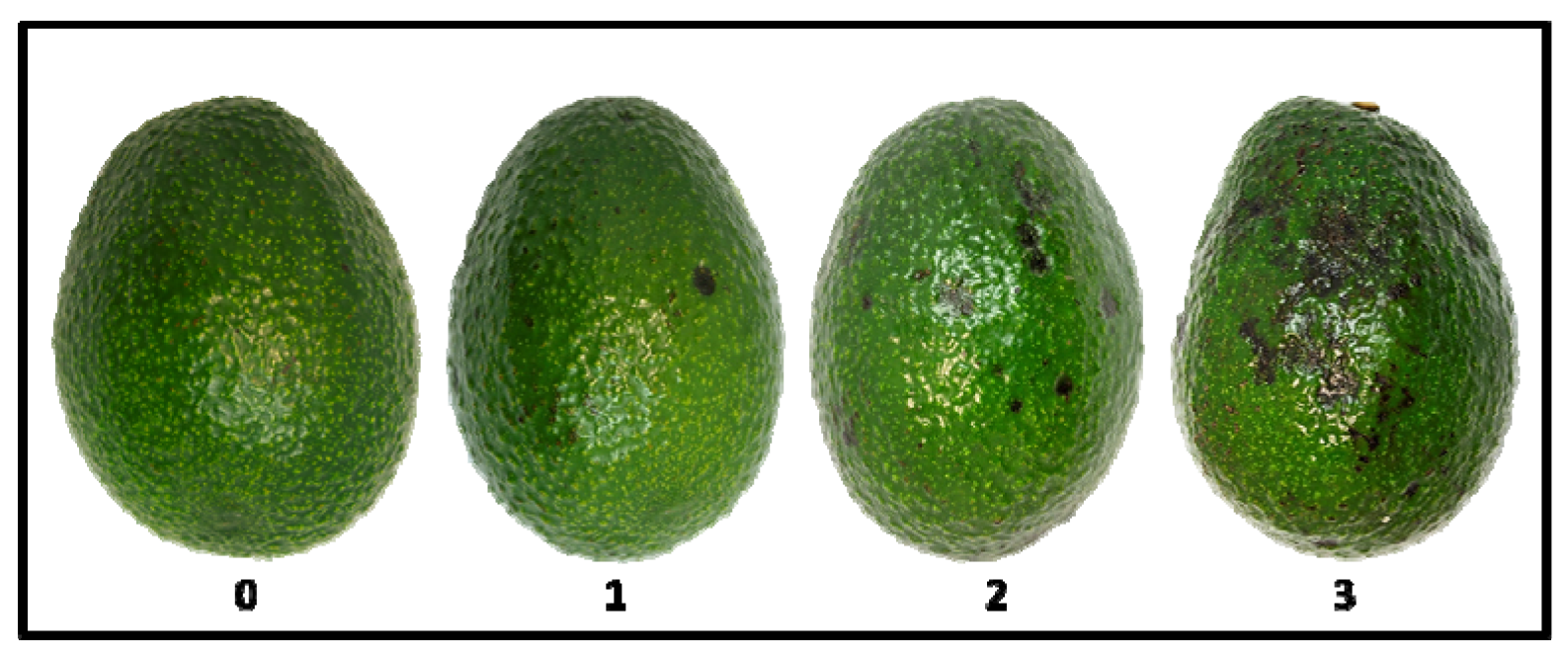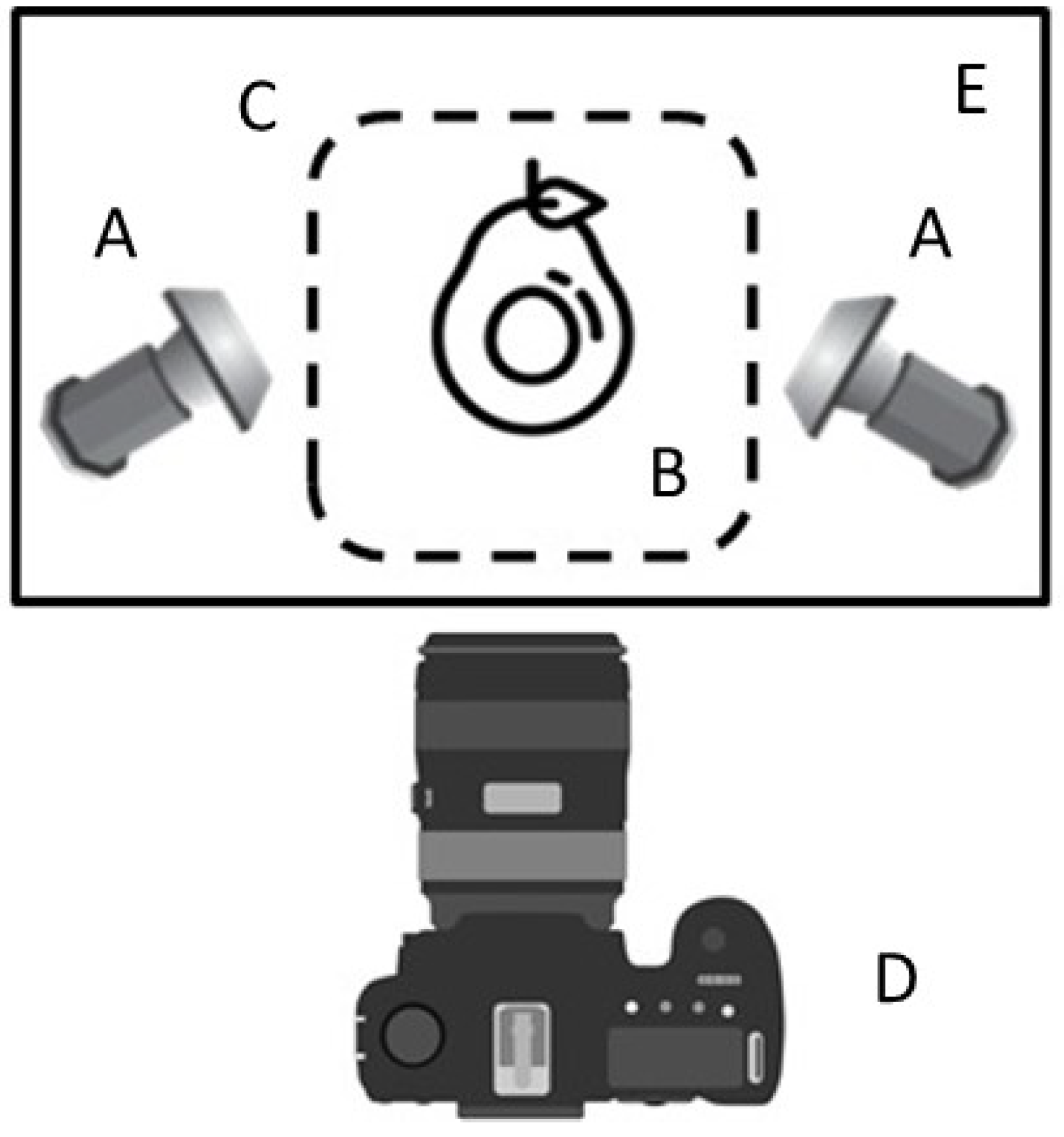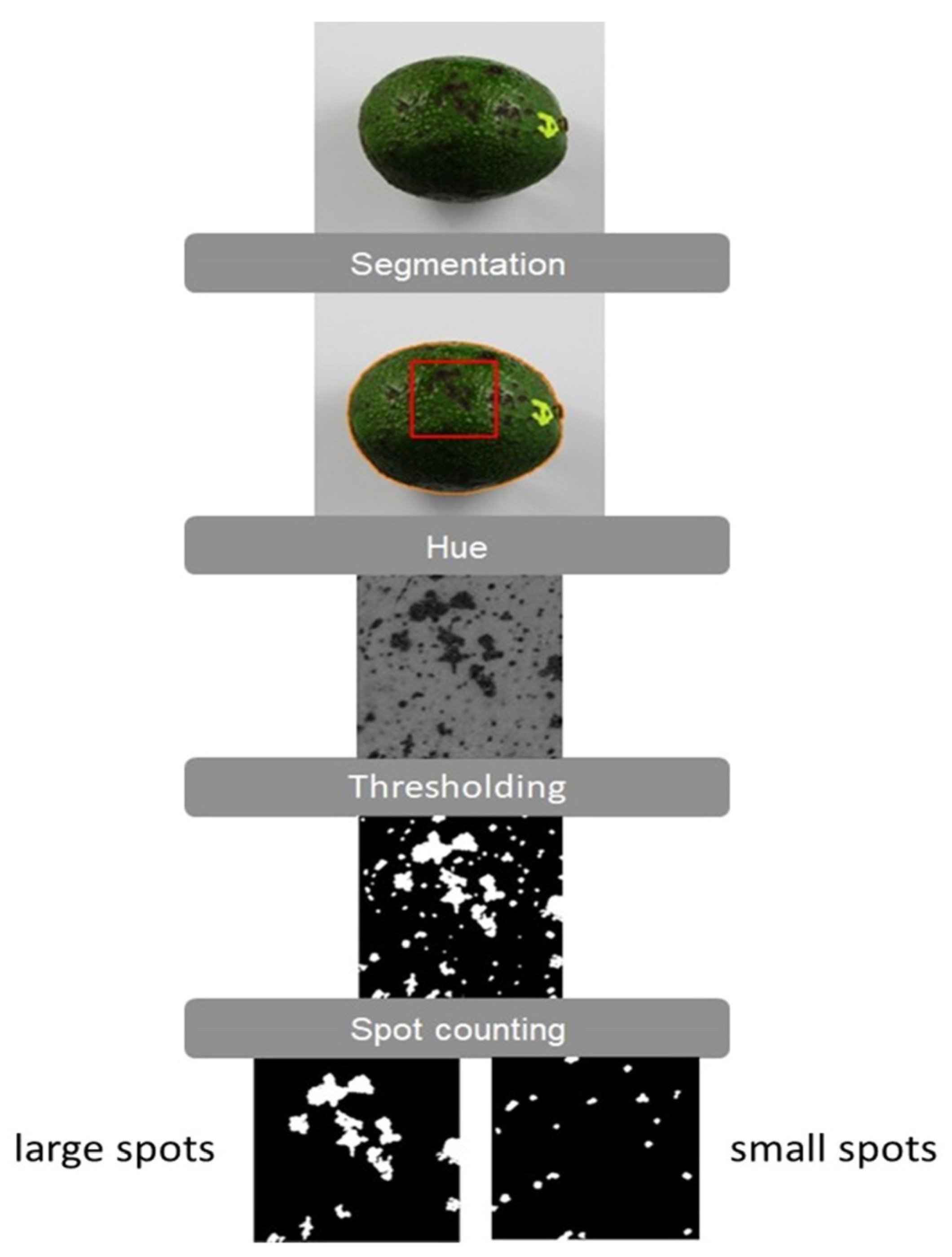Image Analysis Reveals That Lenticel Damage Does Not Result in Black Spot Development but Enhances Dehydration in Persea americana Mill. cv. Hass during Prolonged Storage
Abstract
:1. Introduction
2. Materials and Methods
2.1. Orchard Selection, Geographic Location and Agroclimatic Data Collection
2.2. Harvesting Systems and Harvesting Time
2.3. Harvest Stages and Postharvest Storage Conditions
2.4. Evaluations of Internal and External Quality Parameters
2.4.1. Incidence of Lenticel Damage and Black Spot
2.4.2. Stem End Rot and Anthracnose Incidence
2.4.3. Weight Loss
2.4.4. Determination of Dry Matter and Firmness
2.5. Image Analysis
2.5.1. Description of the Photographic System
2.5.2. Photographic Follow-Up on Fruits
2.5.3. Implementation of Image Analysis Method in Matlab
2.6. Statistical Analysis
3. Results
3.1. Development of the Quantification Method for Lenticel Damage and Black Spot
3.2. Effect of Type and Time of Harvest on Weight Loss and Incidence of Rots
3.3. Evaluation of the Type and Time of Harvest on Lenticel Damage and Black Spot Incidence
3.4. Lenticel Damage Correlates to Water Loss during Storage but Not to Black Spot Development
3.5. Data Integration and Multivariate Analysis
4. Discussion
5. Conclusions
Supplementary Materials
Author Contributions
Funding
Institutional Review Board Statement
Informed Consent Statement
Data Availability Statement
Acknowledgments
Conflicts of Interest
References
- Avocado Source. Available online: http://www.avocadosource.com/Journals/CICTAMEX/CICTAMEX_1998/cictamex_1998_33-51.pdf (accessed on 3 May 2019).
- Dreher, M.L.; Davenport, A.J. Hass Avocado Composition and Potential Health Effects. Crit. Rev. Food Sci. Nutr. 2013, 53, 738–750. [Google Scholar] [CrossRef] [Green Version]
- World Avocados Market Analysis, Forecast, Size, Trends and Insights (WAMAFSTI). Available online: https://www.researchandmarkets.com/reports/4701142/world-avocados-market-analysis (accessed on 12 August 2021).
- Oficina de Estudios y Políticas Agrarias. Ministerio de Agricultura. La Palta Chilena en los Mercados Internacio-Nales. Available online: https://www.odepa.gob.cl/wp-content/uploads/2018/12/palta2018rev1.pdf (accessed on 18 May 2019).
- Comité de Palta Hass. Available online: http://www.paltahass.cl (accessed on 15 May 2019).
- Olivares, D.; Alvarez, E.; Véliz, D.; García-Rojas, M.; Díaz, C.; Defilippi, B.G. Effects of 1-Methylcyclopropene and Controlled Atmosphere on Ethylene Synthesis and Quality Attributes of Avocado cvs. Edranol and Fuerte. J. Food Qual. 2020, 2020. [Google Scholar] [CrossRef]
- Mazhar, M.; Joyce, D.; Hofman, P.; Vu, N. Factors contributing to increased bruise expression in avocado (Persea americana M.) cv. ‘Hass’ fruit. Postharvest Biol. Technol. 2018, 143, 58–67. [Google Scholar] [CrossRef]
- Perkins, M.L.; Usanase, D.; Zhang, B.; Joyce, D.C.; Coates, L.M. Impact Injury at Harvest Promotes Body Rots in ‘Hass’ Avocado Fruit upon Ripening. Horticulturae 2020, 6, 11. [Google Scholar] [CrossRef] [Green Version]
- Mandemaker, A.J.; Elmsly, T.A.; Smith, D.B. Effects of drop heights and harvesting methods on the quality of “Hass” avocados. NZAGA 2006, 6, 97–104. [Google Scholar]
- Uarrota, V.G.; Hernandez, I.; Guequen, E.P.; Cruz, J.V.; Fuentealba, C.; Defilippi, B.G.; Lindh, V.; Zulueta, C.; Chirinos, R.; Campos, D.; et al. Unravelling factors associated with ‘blackspot’ disorder in stored Hass avocado (Persea americana Mill) fruit. J. Hortic. Sci. Biotechnol. 2020, 95, 804–815. [Google Scholar] [CrossRef]
- Hernández, I.; Uarrota, V.; Paredes, D.; Fuentealba, C.; Defilippi, B.G.; Campos-Vargas, R.; Meneses, C.; Hertog, M.; Pedreschi, R. Can metabolites at harvest be used as physiological markers for modelling the softening behaviour of Chilean “Hass” avocados destined to local and distant markets? Postharvest Biol. Technol. 2021, 174, 111457. [Google Scholar] [CrossRef]
- Everett, K.R.; Hallett, I.C.; Rees-George, J.; Chynoweth, R.W.; Pak, H.A. Avocado lenticel damage: The cause and the effect on fruit quality. Postharvest Biol. Technol. 2008, 48, 383–390. [Google Scholar] [CrossRef] [Green Version]
- Zamora-Magdaleno, M.T.; Cajuste-Bontemps, J.; Colina-León, M.T.; Santacruz, U.H. Efecto de los daños mecánicos sobre el comportamiento postcosecha de frutos en aguacate. Rev. Chapingo Ser. Hortic. 1999, 5, 319–328. [Google Scholar]
- Duvenhage, J.A. The influence of wet picking on postharvest diseases and disorders of avocado fruit. SAAGA Yearb. 1993, 16, 77–79. [Google Scholar]
- Ramírez-Gil, J.G.; López, J.H.; Henao-Rojas, J.C. Causes of Hass Avocado Fruit Rejection in Preharvest, Harvest, and Packinghouse: Economic Losses and Associated Variables. Agronomy 2019, 10, 8. [Google Scholar] [CrossRef] [Green Version]
- Ramírez-Gil, J.G.; Henao-Rojas, J.C.; Morales-Osorio, J.G. Postharvest diseases and disorders in avocado cv. Hass and their relationship to preharvest management practices. Heliyon 2021, 7, e05905. [Google Scholar] [CrossRef] [PubMed]
- Gancarz, M. At harvest prediction of the susceptibility of potato varieties to blackspot after impact over long-term storage. Postharvest Biol. Technol. 2018, 142, 93–98. [Google Scholar] [CrossRef]
- Rivera, S.A.; Ferreyra, R.; Robledo, P.; Selles, G.; Arpaia, M.L.; Saavedra, J.; Defilippi, B.G. Identification of preharvest factors determining postharvest ripening behaviors in ‘Hass’ avocado under long term storage. Sci. Hortic. 2017, 216, 29–37. [Google Scholar] [CrossRef]
- Mery, D.; Pedreschi, F. Segmentation of colour food images using a robust algorithm. J. Food Eng. 2005, 66, 353–360. [Google Scholar] [CrossRef]
- Mery, D. BALU: A Toolbox Matlab for Computer Vision, Pattern Recognition and Image Processing. 2011. Available online: http://dmery.ing.puc.cl/index.php/balu (accessed on 17 August 2020).
- Rastislav, L.; Plataniotis, K.N. (Eds.) Color Image Processing: Method Sand Applications; CRC Press: Boca Raton, FL, USA, 2018. [Google Scholar]
- Liu, F.; Kong, Y. Zoib: An R package for Bayesian inference for beta regression and zero/one inflated beta regression. R J. 2015, 7, 34–51. [Google Scholar] [CrossRef] [Green Version]
- Plummer, M. JAGS. 2014. Available online: http://mcmc-jags.sourceforge.net/ (accessed on 8 December 2020).
- Bermúdez, A.; Ballesteros, D.; Sánchez, G. Image analysis for automatic feature estimation of Mangifera indica fruit. Ing. Y Desarro. 2013, 31, 84–104. [Google Scholar]
- Bhargava, A.; Bansal, A. Fruits and vegetables quality evaluation using computer vision: A review. J. King Saud Univ. Comput. Inf. Sci. 2021, 33, 243–257. [Google Scholar] [CrossRef]
- Barbedo, J.G.A. Digital image processing techniques for detecting, quantifying and classifying plant diseases. SpringerPlus 2013, 2, 1–12. [Google Scholar] [CrossRef] [PubMed] [Green Version]
- Bock, C.H.; Poole, G.H.; Parker, P.E.; Gottwald, T.R. Plant disease severity estimated visually by digital photography and image analysis and hyperspectral imaging. Crit. Rev. Plant. Sci. 2010, 29, 59–107. [Google Scholar] [CrossRef]
- Munhuweyi, K.; Mpai, S.; Sivakumar, D. Extension of Avocado Fruit Postharvest Quality Using Non-Chemical Treatments. Agronomy 2020, 10, 212. [Google Scholar] [CrossRef] [Green Version]
- Woolf, A.; Cox, K.; White, A.; Ferguson, I.B. Low temperature conditioning treatments reduce external chilling injury of ‘Hass’ avocados. Postharvest Biol. Technol. 2003, 28, 113–122. [Google Scholar] [CrossRef] [Green Version]
- Gopu, V.; Meena, C.K.; Shetty, P.H. Quercetin influences quorum sensing in food borne bacteria: In-vitro and in-silico evi-dence. PLoS ONE 2015, 10, e0134684. [Google Scholar] [CrossRef] [Green Version]
- Liu, Y.; Chen, Y.R.; Wang, C.Y.; Chan, D.E.; Kim, M.S. Development of hyperspectral imaging technique for the detection of chilling injury in cucumbers; spectral and image analysis. Appl. Eng. Agric. 2006, 22, 101–111. [Google Scholar] [CrossRef]
- Mendieta, B.; Olaeta, J.A.; Pedreschi, R.; Undurraga, P. Reduction of cold damage during cold storage of Hass avocado by a combined use of pre-conditioning and waxing. Sci. Hortic. 2016, 200, 119–124. [Google Scholar] [CrossRef]
- Everett, K.R.; Hallett, I.; Yeasley, C.; Lallu, N.; Rees-George, J.; Pak, H.A. Morphological changes in lenticel structure resulting from imbibition and susceptibility to handling damage. NZAGA 2001, 1, 47–53. [Google Scholar]
- Blakey, R.J.; Tesfay, S.Z.; Bertling, I.; Bower, J.P. Changes in sugars, total protein, and oil in ‘Hass’ avocado (Persea americana Mill.) fruit during ripening. J. Hortic. Sci. Biotechnol. 2012, 87, 381–387. [Google Scholar] [CrossRef]







| Orchard | System | WL at 5 °C (%) | WL at Exit Storage (%) | WL at RTE (%) | Black Spot (SI%) | Lenticel Damage (SI%) | |||||
|---|---|---|---|---|---|---|---|---|---|---|---|
| 9:00 | 14:00 | 9:00 | 14:00 | 9:00 | 14:00 | 9:00 | 14:00 | 9:00 | 14:00 | ||
| Rancho | Appropriate | 0.75 ± 0.11 aA | 0.54 ± 0.07 aA | 5.70 ± 0.13 aA | 5.70 ± 0.13 aA | 14.3 ± 0.27 aB | 13.07 ± 0.63 bA | 22.2 ± 0.0 bA | 36.8 ± 0.0 bB | 20.8 ± 0.0 aB | 16.6 ± 0.0 aA |
| Conventional | 1.08 ± 0.07 bA | 1.01 ± 0.09 bA | 6.55 ± 0.14 bB | 5.58 ± 0.13 aA | 13.7 ± 0.47 aB | 11.2 ± 0.23 aA | 19.9 ± 0.0 aA | 26.8 ± 0.0 aB | 24.4 ± 0.0 bB | 23 ± 0.0 bA | |
| Quilhuica | Appropriate | 0.99 ± 0.12 aA | 1.50 ± 0.27 aB | 5.87 ± 0.16 aA | 6.60 ± 0.39 aA | 10.26 ± 0.35 aA | 13.85 ± 0.59 aB | 0 ± 0.0 aA | 0 ± 0.0 aA | 11.4 ± 0.0 aB | 9.25 ± 0.0 aA |
| Conventional | 0.88 ± 0.12 aA | 1.32 ± 0.10 aB | 5.95 ± 0.38 aA | 6.95 ± 0.30 aB | 12.36 ± 0.83 bA | 13.29 ± 0.60 aA | 0 ± 0.0 aA | 0 ± 0.0 aA | 19.2 ± 0.0 bA | 30 ± 0.0 bB | |
| La Ensenada | Appropiate | 0.39 ± 0.03 aA | 0.30 ± 0.009 aA | 4.58 ± 0.23 aA | 4.53 ± 0.38 aA | 10.25 ± 0.29 aB | 8.63 ± 0.26 aA | 0 ± 0.0 aA | 0 ± 0.0 aA | 12.5 ± 0.0 aA | 30 ± 0.0 aB |
| Conventional | 0.88 ± 0.05 bA | 0.65 ± 0.16 bA | 4.92 ± 0.31 aA | 4.59 ± 0.22 aA | 9.51 ± 0.34 aA | 8.88 ± 0.29 aA | 0 ± 0.0 aA | 0 ± 0.0 aA | 23 ± 0.0 bA | 30 ± 0.0 aB | |
| Orchard | System | WL at 5 °C (%) | WL at Exit Storage (%) | WL at RTE (%) | Black Spot (SI%) | Lenticel Damage (SI%) | |||||
|---|---|---|---|---|---|---|---|---|---|---|---|
| 9:00 | 14:00 | 9:00 | 14:00 | 9:00 | 14:00 | 9:00 | 14:00 | 9:00 | 14:00 | ||
| Rancho | appropriate | 0.56 ± 0.10 aA | 0.49 ± 0.04 aA | 5.73 ± 0.33 aA | 5.43 ± 0.09 aA | 10.09 ± 0.38 aA | 11.55 ± 0.31 bB | 4.6 ± 0.0 aA | 11.88 ± 0.0 bB | 28.2 ± 0.0 aA | 28.75 ± 0.0 aB |
| Conventional | 0.38 ± 0.03 aA | 0.53 ± 0.1 aA | 6.6 ± 0.35 bB | 5.73 ± 0.33 aA | 10.03 ± 0.28 aA | 10.10 ± 0.38 aA | 11.5 ± 0.0 bB | 6.58 ± 0.0 aA | 35 ± 0.0 bB | 30.26 ± 0.0 bA | |
| Quilhuica | appropriate | 0.66 ± 0.13 aA | 0.71 ± 0.009 aA | 3.31 ± 0.07 aA | 3.42 ± 0.11 aA | 8.50 ± 0.19 aA | 9.69 ± 0.35 bB | 0 ± 0.0 aA | 0 ± 0.0 aA | 27.6 ± 0.0 aB | 17.8 ± 0.0 aA |
| Conventional | 0.73 ± 0.03 aA | 0.48 ± 0.05 aA | 4.13 ± 0.42 bB | 2.89 ± 0.08 aA | 9.57 ± 0.47 bB | 7.87 ± 0.29 aA | 0 ± 0.0 aA | 0 ± 0.0 aA | 37.4 ± 0.0 bB | 19 ± 0.0 bA | |
| Bartolillo | appropriate | 0.22 ± 0.03 aA | 0.37 ± 0.04 aB | 4.82 ± 0.14 aA | 4.57 ± 0.08 aA | 8.34 ± 0.19 aA | 7.98 ± 0.18 aA | 31.75 ± 0.0 bB | 28.75 ± 0.0 aA | 36.6 ± 0.0 aB | 26.6 ± 0.0 bA |
| Conventional | 0.61 ± 0.04 bB | 0.36 ± 0.06 aA | 6.77 ± 0.41 bB | 5.21 ± 0.14 aA | 11.62 ± 0.44 bB | 8.88 ± 0.21 bA | 16.75 ± 0.0 aA | 31.52 ± 0.0 bB | 53.86 ± 0.0 bB | 23.8 ± 0.0 aA | |
Publisher’s Note: MDPI stays neutral with regard to jurisdictional claims in published maps and institutional affiliations. |
© 2021 by the authors. Licensee MDPI, Basel, Switzerland. This article is an open access article distributed under the terms and conditions of the Creative Commons Attribution (CC BY) license (https://creativecommons.org/licenses/by/4.0/).
Share and Cite
Lindh, V.; Uarrota, V.; Zulueta, C.; Alvaro, J.E.; Valdenegro, M.; Cuneo, I.F.; Mery, D.; Pedreschi, R. Image Analysis Reveals That Lenticel Damage Does Not Result in Black Spot Development but Enhances Dehydration in Persea americana Mill. cv. Hass during Prolonged Storage. Agronomy 2021, 11, 1699. https://doi.org/10.3390/agronomy11091699
Lindh V, Uarrota V, Zulueta C, Alvaro JE, Valdenegro M, Cuneo IF, Mery D, Pedreschi R. Image Analysis Reveals That Lenticel Damage Does Not Result in Black Spot Development but Enhances Dehydration in Persea americana Mill. cv. Hass during Prolonged Storage. Agronomy. 2021; 11(9):1699. https://doi.org/10.3390/agronomy11091699
Chicago/Turabian StyleLindh, Vicente, Virgilio Uarrota, Claudio Zulueta, Juan E. Alvaro, Monika Valdenegro, Italo F. Cuneo, Domingo Mery, and Romina Pedreschi. 2021. "Image Analysis Reveals That Lenticel Damage Does Not Result in Black Spot Development but Enhances Dehydration in Persea americana Mill. cv. Hass during Prolonged Storage" Agronomy 11, no. 9: 1699. https://doi.org/10.3390/agronomy11091699
APA StyleLindh, V., Uarrota, V., Zulueta, C., Alvaro, J. E., Valdenegro, M., Cuneo, I. F., Mery, D., & Pedreschi, R. (2021). Image Analysis Reveals That Lenticel Damage Does Not Result in Black Spot Development but Enhances Dehydration in Persea americana Mill. cv. Hass during Prolonged Storage. Agronomy, 11(9), 1699. https://doi.org/10.3390/agronomy11091699






